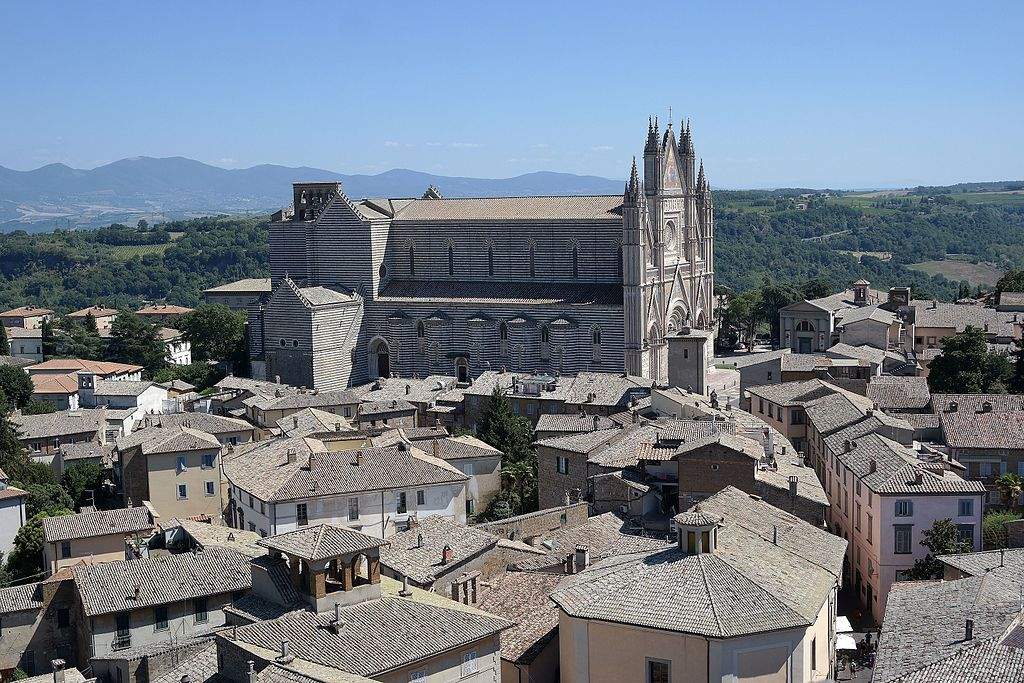A great return to Orvieto Cathedral: after a full 122 years, the 12 statues of the apostles and four of the patron saints made on several occasions and by different sculptors between 1556 and 1722 return to the famous Umbrian house of worship. A relocation that follows that, which took place in March, of the sculptural group of theAnnunciation, a masterpiece by the proto-baroque sculptor Francesco Mochi (Montevarchi, 1580 - Rome, 1654), made between 1603 and 1608 on commission from the Opera del Duomo of Orvieto.
As for the statues of the apostles, the first to be made was St. Paul, by Francesco Mosca known as Moschino (Florence, 1523? - Pisa, 1578) from 1556; followed by St. Peter by Raffaello da Montelupo (Montelupo Fiorentino, 1504 - Orvieto, 1566) from 1557, St. Thomas, St. John and St. Andrew by Ippolito Scalza (Orvieto, 1532 - 1617) and collaborators, St. James the Greater by Giovanni Caccini (Montopoli in Val d’Arno, 1556 - Florence, 1613), St. Matthew by Pietro Francavilla (Pierre Franqueville; Cambrai, 1548 - Paris, 1615) based on a design by Giambologna and Francesco Mochi’s St. Philip, all works made within 1612. Later works, on the other hand, are St. Bartholomew, a 1618 work by Ippolito Buzi (Viggiù, 1562 - Rome, 1634), St. Thaddeus sculpted by Mochi in 1644, and St. James the Less and St. Simon by Bernardino Cametti, made in 1722. The four patron saints of the city are the 1593 St. Rocco, 1598 St. Costanzo and 1601 St. Brizio, all works by Fabiano Toti (? - Orvieto, 1607), and the 1554-1557 St. Sebastian by Moschino and Scalza.
The statues were removed from Orvieto Cathedral in 1897 (at that time, in fact, it was desired to give the cathedral its austere medieval appearance once again, and the Baroque additions, starting with the statues, were therefore removed) and in recent years they were on display in a detached location of the Museo dell’Opera del Duomo, the former church of Sant’Agostino. Their relocation to their original location has been talked about since 1986 (one of the most vocal advocates for their return to the Duomo was Federico Zeri), the time when the superintendency’s first project dates back to, but it could only be realized this year: several parties contributed to the result, namely the superintendence itself, the Opera del Duomo, the Municipality of Orvieto, the diocese of Orvieto-Todi and Enea, which oversaw the scientific and innovative aspects of seismic risk prevention (in fact, all the statues were equipped with earthquake-proof bases). The return of the statues also provided an opportunity to carry out structural verifications of the cathedral’s architectural elements and some interventions to improve its behavior in case of earthquakes.
“This project in its complexity represents an unprecedented case in the history of restoration,” said Opera del Duomo President Gianfelice Bellesini. “Institutions and professionals, with passion and expertise, led a team effort thanks to which, in a reasonable time, we managed to put an end to this melancholy exile. This is a great emotion for us.” About the seismic improvements, Gerardo De Canio, ENEA researcher who oversaw the work, said that “the bases of the statues were reconstructed with fragments of the original materials and solutions to improve their seismic behavior. In addition, we carried out interventions to reduce the seismic mass, anchor the pillars to the floor and place the pillars’ base plinths flush.” Professor Antonio Paolucci, who was present yesterday during the inauguration ceremony, said that “the statues of the Apostles and patron saints, which after 122 years have returned to the cathedral, represent a brilliant catechetical and theological idea.” Writer Susanna Tamaro, who is a member of the Opera del Duomo of Orvieto, commented that “the return of the splendid statues comes at the outcome of a challenging journey and undoubtedly represents an extraordinary restitution of a context denied for long years.”
The important event was presented yesterday at 5 p.m. by Antonio Paolucci, who has always been one of the most active supporters of the return of the works to the cathedral: the presentation was followed by a theological reading by Monsignor Giacomo Morandi, secretary of the Congregation for the Doctrine of the Faith, and the solemn blessing given by the bishop of Orvieto, Benedetto Tuzia. The presentation will be followed by several events that will conclude with the Corpus Christi celebrations: there will also be a photographic exhibition on the return of the statues, set up in the basement of Orvieto’s Museo dell’Opera del Duomo, which will be inaugurated on December 7 and will be open to visitors free of charge until April 12, 2020.
Pictured: the Orvieto Cathedral as seen from the Torre del Moro. Ph. Credit
 |
| Orvieto, monumental statues of apostles and patron saints return to the cathedral after 122 years |
Warning: the translation into English of the original Italian article was created using automatic tools. We undertake to review all articles, but we do not guarantee the total absence of inaccuracies in the translation due to the program. You can find the original by clicking on the ITA button. If you find any mistake,please contact us.